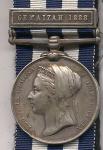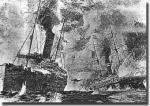-
Posts
29,251 -
Joined
-
Last visited
-
Days Won
84
Content Type
Profiles
Forums
Blogs
Gallery
Events
Store
Everything posted by Chris Boonzaier
-

Rare Egypt bar
Chris Boonzaier replied to Chris Boonzaier's topic in Great Britain: Orders, Gallantry, Campaign Medals
-
I found this one in cairo. it is unnamed (not erased) and a couple of folks have said that means it has come from the mint, but I doubt that. I dont think they put bars on before knowing who to name them to and there are knocks on the lefthand side that seem to point to it having been worn with a star of some kind. maybe to an Egyptian and they were not to pedantic with the naming?
-
Here ya go..... This encouraged our hopes that the Greif, an auxiliary cruiser sent out a few days previously under Captain Tieze, would have an equally successful trip. Unfortunately, news came to hand a few weeks later that she had been held up on the English guardship line between the Shetlands and Norway, and after a fierce fight had succumbed, but not until she had torpedoed and sunk the auxiliary cruiser Alcantara, a vessel three times her size. This first encounter, in which the Greif had already suffered severely, attracted a second auxiliary cruiser, the Andes, and the light cruiser Comus, which came up with two destroyers and joined in the fight. Faced by such superior forces, Tieze, after a fierce fight lasting two hours, left the ship, with the surviving members of the crew, and sank her. While the English at first took part in the rescue of the crew, the Comus, according to the statements of prisoners since returned home, again opened fire on the lifeboats and rafts, asserting that a U-boat had been sighted. The result was that several others were killed, the commander among the number. Commander Nevetzky, First Lieut. Weddigen, and Lieut. Tiemann, had already been killed in the battle. About two-thirds of the crew were taken prisoners by the English.
-
Some more........ London Gazette 22 June 1916. The original recommendation states: ?Officer?s Steward Richard Henry Buckett behaved with great coolness and assisted wounded when the ship was sinking.? The liner Alcantara was requisitioned by the Admiralty soon after the outbreak of hostilities in August 1914 and was converted into an auxiliary cruiser. She subsequently joined the 10th Cruiser Squadron and was placed under the command of Captain T. E. Wardle, her chief duty being patrol work between Scapa Flow and the coast of Norway. D.S.M. London Gazette 22 June 1916. The original recommendation states: ?Officer?s Steward Richard Henry Buckett behaved with great coolness and assisted wounded when the ship was sinking.? The liner Alcantara was requisitioned by the Admiralty soon after the outbreak of hostilities in August 1914 and was converted into an auxiliary cruiser. She subsequently joined the 10th Cruiser Squadron and was placed under the command of Captain T. E. Wardle, her chief duty being patrol work between Scapa Flow and the coast of Norway. At about midday on 28 February 1916, in a position of 60 miles E. of the North of the Shetlands, the Alcantara was due to rendezvous with her relief ship, the Andes, when a wireless message instructed her to remain thereabouts and keep a sharp lookout for a suspicious steamship coming out of the Skagerrak. But it was not until about 8.45 a.m. on the following morning that Captain Wardle spotted smoke on the horizon on his port beam. During the course of making passage to this unidentified steamship, he received a wireless warning from the Andes that this was in all probability the vessel he was seeking, so Wardle signalled to the latter to stop, and fired two rounds of blank ammunition. By this stage the two ships had approached to within 1,000 yards of each other, the Alcantara coming up astern and lowering a boarding boat. At that moment, however, the ?stranger? - which had Norwegian colours painted on her side and the name Rena-Tonsberg - dropped her bulwarks and ran out her guns. She was, infact, the enemy raider Greif, and the intense nature of the ensuing 20 minute duel is best described in Deeds That Thrill The Empire: ?From the very first the British gunners got home on the enemy. His bridge was carried away at the first broadside, and then, systematically, our guns searched yard by yard along the upper works of the enemy, seeking out the wireless room from which were emanating the meaningless jargons that ?jammed? the Alcantara?s wireless. This had been set to work at once to call up assistance - a proper fighting precaution in any event, but doubly so in this case, seeing that it was quickly apparent the Greif carried considerably heavier ordnance than her own. Before long the enemy?s wireless was smashed, and our guns promptly turned themselves upon the hull and water-line of their opponent. In a few minutes the Greif had a great fire blazing aft; a few more, and she began to settle down by the stern; and as the Alcantara?s guns methodically and relentlessly searched her from stem to stern her return fire grew more and more feeble until, after about fifteen minutes? fighting, it died away almost entirely. On paper, judging by the difference between the armaments, the Alcantara ought to have been blown out of the water by this time; but, although she was hit frequently, the actual damage she sustained was almost negligible. The Greif was already a beaten and doomed craft when other vessels came up in answer to Alcantara?s wireless. The first to arrive was the Andes, Captain George B.W. Young (another converted unit of the Royal Mail Steam Packet Line), and a few rounds from her apparently completed the enemy?s discomfort. Not long after, a ?pukka? cruiser appeared on the scene; but it is reported that, seeing the Alcantara had already made a hopeless mess of her opponent, this cruiser clicked out the signal ?Your Bird? and went about her other business! But the fight was not yet over. The Greif had again begun to blaze away with the one or two guns that remained intact when there happened one of those misfortunes that are apt to occur to the most efficiently handled ships. An unlucky shot carried away the Alcantara?s steering-gear, and her captain was immediately robbed of the weapon upon which he had chiefly depended for the destruction of his enemy - his seamanship. The Alcantara, though nearly all her guns were intact, became unmanageable, and for the first time in the action she was swung round by the seas into such a position that her full broadside was exposed to the enemy. There had, too, been no half-measures in fitting out the Greif for her work. She carried not only a powerful equipment of guns, but also torpedo tubes, and, although she was fast settling down in the water, she was able to bring them to bear now on a most favourable target - a big ship lying broadside on with disabled steering-gear. The first two torpedoes that were fired missed - in spite of the short range. The third caught the Alcantara squarely. Whereby it happened that after some twenty minutes of the most fierce and closely contested fighting the naval campaign had seen, the two principal combatants found themselves making headway towards the bottom in company. The Greif was the first to go. It is believed that, like the Moewe, she carried a big cargo of mines to be strewed where they would be most likely to entrap our warships. However that may be, she blew up with a tremendous explosion and went to the bottom, just a few minutes before the mortally injured Alcantara turned over on her side to find a resting place within a few hundred yards of her ... Of the 321 officers and men with which the Greif entered the fight, five officers and 115 men were rescued from the sea and made prisoners by the British destroyers that came upon the scene. The remaining 201 went to the bottom with their ship. The Alcantara?s loss amounted to five officers and 69 men, of whom nearly all were killed by the final torpedo.? Richard Henry Buckett, who was among the survivors and awarded the D.S.M. for gallantly assisting the wounded, was subsequently lost in the armed boarding ship Stephen Furness, when that vessel was torpedoed in the Irish Channel on 21 December 1917 - she went down with the loss of six officers and 95 ratings. A native of Ningwood on the Isle of Wight, he was 51 years of age and left a widow, Emily Jane Buckett. The DSM Medal awarded to R H Buckett was sold at auction in Sep 2005 for ?1600.
-
The Full story, copied from the web... Greif Only operational from the 23rd. of January to the 29th. of February 1916, and in that time managed to claim but one vessel of 15,831 tons. Launched as Guben on the 29th. of July 1914, this cargo ship of just on 5, 000 tons had a service speed of 13 knots. At the commencement of 1916, Grief was pressed into Naval service and sailed for Kiel for a dockyard conversion into an Armed Merchant Ship. Built with two funnels, quite unusual in a tramp steamer, the second funnel was removed, and 4 by 15cm. guns were added, two on the upper deck between her bridge and foremast, and two more, one on each beam before her mainmast. A further single 10.5cm. was hidden in a gunhouse on the after deck, and two torpedo tubes were also added. She thus became a quite formidible weapon if met on the trade routes by an unsuspecting Allied ship sailing alone, unprotected by the strength of a convoy and its associated escorts. Grief moved on the 25th.of February 1916 from Kiel to Hamburg, then sailed two days later moving out into the North Sea. Poor weather obtained, mist and snow flurries being severe enough for the accompanying Submarine U-70 to lose contact with her charge. This U-Boat reported seeing a British Submarine which appears to have reported Grief's position to the British Admiralty. Admiral Jellicoe on the 28th of February at 2338 (11.38 PM) sailed light cruisers Cordelia and Inconstant with four attendant Destroyers from Rosyth in Scotland. Three more cruisers, Calliope, Comus, and Blanche with a further three Destroyers sortied out of the fleet base at Scapa Flow to back up the Armed Merchant Cruisers of the 10th. Cruiser Squadron. Sister ships owned by the Royal Mail Steamship Packet Company, Andes (15,620 tons) and Alcantara (15,831 tons) had joined the Royal Navy in April of 1915, each were fitted with 8 by 6 inch guns, plus 2 pounders, and had a speed of 17 knots, which was adequate to outrun any freighter or cargo vessel they were likely to encounter on the high seas. At 0845 (8.45 AM) on the last day of February (1916 was a leap year) lookouts in Alcantara reported smoke on the port beam. In both world wars at sea, it was the sighting of smoke in the distance, that so often alerted an enemy (on both sides of the conflict) to the presence of a single ship, or even ships in convoy. The making of smoke was to be avoided at all costs, and many a Captain on his bridge of a merchant ship or a warship, would become most upset at its appearance from the funnel of his command, and then vent his wrath on the engine room department in general and on his chief engineer in particular. Andes now reported sighting a black painted ship with 2 masts and a black funnel. Alcantara was closer and Captain Thomas Wardle increased speed to bring his ship between Andes and this suspicious looking vessel, as he closed Greif, two large Norwegian flags,and RENA and TONSBERG could be made out on the ship's side. Greif trurned away to the north east, Wardle now hoisted the signal to stop instantly, MN. and fired two blank rounds to reinforce his order. Greif now hove to, and signalled she was sailing out of Trondheim and was bound for Rio de Janiro and La Plata. At 0940 (9.40 AM) when the Armed Merchant Cruiser was preparing to lower a boat to send over a boarding party, Greif suddenly declared her intent, dropped the gunhouse around her poop gun, opened fire, and at a range of only 800 yards, her first shell striking home on Alcantara's bridge, wrecked it, and destroyed the engine room telegraph and communications equipment. (Captain Wardle had made the fatal mistake of bringing his ship too close, instead of standing off at a safe distance until this ship could be properly identified.) Now unmasking her other guns, the German Raider poured shells into Alcantara, destroying boats and her steering gear. At last Alcantara came to life, increasing speed, trying to block Greif from making for the Norwegian coastline, her port after 6 inch gun with its first shell scored a bull's eye on Greif's poop gun, putting it out of action, and killing most of this gun's crew. The sound of this action brought Andes, some 5 miles away, scurring back to assist her shipmate. Opening fire from a range of 3 miles, Andes landed a direct hit on Greif's bridge which wrecked her steering gear. Meantime, Greif and Alcantara were engaged in an old fashioned, close range slug fest, with each ship gaining repeated hits upon the other ship's waterline. The Raider's port forward 15cm. gun was knocked out, her fuel tanks were set alight, and a third shell penetrated her hull to explode in the engine room. Aboard Alcantara, a torpedo from Greif struck amidships, and a second torpedo passed under her stern. But Greif was mortally wounded, she was under fire from both British Armed Merchant Cruisers, and, she ceased fire at 1018 (10.18 AM) and four minutes later, boats were seen to be pulling away from the blazing wreck. The German Captain was escaping down a rope ladder over his ship's port quarter when a fragment from one of Alcantara's shells decapitated him. Meantime, Alcantara listing to port, also appeared doomed, and Captain Wardle ordered his company to abandon ship at 1045. (10.45 AM) By 1102 (11.02 AM) the British ship had slipped beneath the surface of the ocean and was gone, 72 men being lost. They had paid the price for their Captain's indescretion of closing too close to an unknown vessel, before it was really identified. This lesson had still not been properly learned in WW2, the Australian light cruiser HMAS Sydney, in November 1941, off the west coast of Western Australia ran into the German Armed Merchant Ship, Kormoran, steamed too close, and was mortally wounded by the German ship. Sydney was last observed steaming away into the distance, on fire. She was never seen again, going down somewhere in the Indian Ocean with her entire company lost. To this day, her final resting place is still not known. Komoran also sank, but many of her crew survived to land on Australia's western coastline, and be rescued. Greif was still afloat, when the Cruiser Comus arrived on the scene with the Destroyer Munster, and Comus proceeded to finish off the German ship, and she finally sank by the stern at 1301 (1.01 PM) with her German Ensign still flying defiantly. It would seem that about 187 of Greif's crew perished, whilst Captain Wardle, his remaining crew, 120 Germans including 5 of their Officers were rescued from the sea by Andes and Munster. This classic battle between Greif and Alcantara had indeed resulted in "an eye for an eye" as yet one more German Raider lived to have but a very short career.
-
They did some hard fighting... 1915 in Flanders, fought in Verdun in the opening phases, Feb 1916 then in July-august very heavy fighting in a new push at Verdun...then a short rest, then into the grinder at Sailly-Saillisel for the Somme battle before returning to Verdun in November..... Yup... 1916 was a good year for Bordeaux wines... but a bad one for the 99. I.R.....
-

Moroccans, Belgian Agents and a big nosed Spaniard...
Chris Boonzaier replied to Chris Boonzaier's topic in Africa
Hi Stijn, Here you go... http://gmic.co.uk/index.php?showtopic=3245 best Chris










